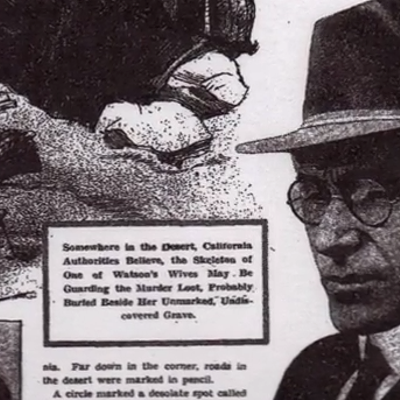Over the past few months, many visitors to the new Northwest Museum of Arts and Culture's "Small Towns" exhibit have stopped in front of a singular glass case. Inside it hangs the painting of a spaghetti-legged rodeo clown who has just wrapped his red blanket around a snorting brahma bull. The back of the animal's muscular neck, colored like an angry bruise, snakes down from its shoulder hump toward eyes and nostrils that glow like angry coals. In front of the painting rests a small terra cotta dory, glazed in beige and ocean blue. The boat is occupied by two fisherman outfitted in foul-weather gear; while one rows hard, the other turns to blow his signal horn.
The painting, titled "Homer Holcombe, Rodeo Clown," was signed by Stevens County artist Leno Prestini in 1959. Prestini also fashioned the terra cotta rowboat, probably around 1937. These two pieces of artwork provide only a small glimpse into Prestini's universe: around the corner, another glass case contains a black diver's helmet pounded out of an old hot water heater. The Captain Nemo helmet is accompanied by a pair of leaden shoes and photographs that show a fully suited diver preparing to take to the water. In real life, Prestini wore that homemade diving outfit as he explored local lakes and rivers during the Depression.
It took these elements and many more to form Prestini's kaleidoscopic vision of the Inland Northwest. This year, as we mark the 40th anniversary of his death, it has become almost impossible to separate Prestini's eventful life from the stories told by his own bewitching brand of folk art. The only way to tackle him is to start at the beginning and lay out what is known as mostly true.
Leno's parents were born in northern Italy. Like many in their small village of Besano, Luigi and Caterina Prestini crossed the border to Zurich, Switzerland, to find work, but Caterina journied home to bear both of her sons. When the family was confronted by hard times, Luigi left for America by himself in 1907. He found work cutting stone in the granite quarries of Barre, Vt., and Caterina followed him a year later with Battista and Leno, aged three and two.
Even in those early days, it was known in the quarries that few stonecutters worked past the age of 40 because of silicosis, rock dust in the lungs. Uncle Federico Prestini had escaped that fate by moving West and establishing his own stump ranch on Half Moon Prairie, just north of Spokane. His letters back to Vermont were so enthusiastic that in 1911, Luigi and Caterina decided to join him. Within a couple of years, they drifted farther north to Clayton, 25 miles north of Spokane, between Deer Park and Loon Lake. In Clayton, Luigi joined an established Italian community based around a terra cotta operation that was part of the Washington Brick Company.
Their life in Clayton was physical and demanding. While Luigi hammered at terra cotta molds with a chisel or air hammer, Caterina washed clothes for the local schoolteacher to supplement their income. The boys helped to raise rabbits and garden vegetables, and buck-sawed endless lengths of jack pine for firewood. Battista, called Bee, recalled that his mother was not happy with the house they found for themselves beside the old East Clayton sawmill, but the boys managed to have their fun. They played ball in the sawdust pile, walked to Loon Lake to fish for perch, swam in the flume beside the railroad tracks and generally pried into whatever mischief was available. One evening, Luigi brought some clay home from the plant and encouraged the boys to try modeling a metal savings bank they had that was shaped like a lion. Leno, showing an immediate feel for his material, molded the clay into an exact replica of the living animal.
In 1919, Luigi contracted a fatal case of pneumonia while recovering from a stomach operation. After that, Caterina took in a couple of boarders to help out, but she couldn't shake her blues. Battista dropped out of school to work as a water boy at the brick plant for $1.50 a day. Leno stuck with high school for a year-and-half before he quit so he could begin exploring the world on his own. According to Battista's unpublished memoirs, Leno stayed rail-thin, intense and aggressive. At one point, he had a "bad nervous spell" and attempted suicide by sitting in a running car in the family garage. Battista was working in the terra cotta plant at the time, pressing tiles as piecework, and he asked Leno to come and join him in 1925. Leno was 19 years old when he began an apprentice in the terra cotta craft. Within a year, he had laid the cornerstone on a new high school down in the Palouse and mortared in some of the terra cotta ornamentation that still graces the community-built Clayton Moose Lodge.
Over the next decade, Leno emerged as a unique figure in local lore. He proved himself to be a gifted design artist crossed with a clever engineer, a broad conversationalist and a mad adventurer. He seemed to breathe in the human and natural landscapes of northeastern Washington — including the brick plant and its machine shop; the region's sawmill and mining culture; its mountains, coniferous forests and deep natural lakes; the horses and tribal gatherings; the taverns, churches and country music — and then spit them back out in ways that were both utterly familiar and entirely new.
When Leno decided he wanted to sail on Loon Lake, he fashioned a craft with cement sack sails and an iron rudder oriented like an airplane rudder. The keel was a coffin cover held in place with strap iron, and Bee said that every change in wind and boat speed would make the strap play a different tune. After seeing a round diving helmet made by a Spokane man, Leno and his buddy Burton Stewart torched a helmet out of a hot water heater, decorated it with an octopus and installed double glass to prevent the faceplate from fogging. When they started descending beyond available sunlight, they cobbled up an underwater flashlight from a six-cell battery enclosed in an aluminum cylinder, with a fuse head to hold the glass and a Model T radiator cap to seal the end.
As their dives in Loon Lake approached 90 feet, they ordered balloon cloth straight from the Goodyear Company to sew into a suit that could handle the cold temperatures. A stainless steel cream can provided the basis for an improved helmet, and a beer barrel pressure pump supplied their air through a common garden hose. The outfit was such a success that the guys displayed it at the Spokane Fair that fall, and they received a call to help local police locate the body of a drowned man in a lake outside of Colville. In time, they almost drowned themselves diving for gold below Z Canyon, that famously fast and dangerous stretch of the lower Pend Oreille River.
Leno's hands and mind, working together, seemed to spawn an endless stream of new schemes. He and his brother built the hull of a speedboat, but the Depression took hold and they couldn't afford a motor to power it. He and Burt Stewart climbed peaks from Mount Spokane to the Canadian border, and when the terra cotta plant shut down for a brief period, they customized a 10-foot ladder and scaled the kiln's 110-foot brick smokestack, taking panoramic photographs from the top to prove it. After reading about land speed records being set at Daytona Beach, Leno fashioned a custom sports car with an airfoil rudder.
Beginning in 1931, Leno molded an odd variety of figures out of clay during his spare time at the plant. After they dried, he would spray them with glaze and fire them in the kiln alongside regular batches of terra cotta. Cecil Sater and Frank Frey, fellow modelers at the plant, also made whimsical terra cotta pieces. Cecil Sater had completed some religious paintings for preachings that he did, and Leno absorbed those, too. In time, his subjects ranged from a diver dodging sharks to an elf lamp to a two-headed mountain climber, and all of the pieces expressed some of Leno's unquiet mental edge. When Battista asked him why the mountain climber had to have two heads, Leno replied, "Every time I get to the top of the mountain, my problems are still with me."
In a 1958 interview with the Colville Statesman-Examiner, Leno succinctly laid out the course of his artistic work, from the Washington Brick and Lime Company to his personal canvases. "At the plant in Clayton, I learned to work with my hands," he related. "An architect would make a rough sketch of an ornament for a building -- an angel in flight, perhaps. But the detail would be up to me. Each man worked that way, and so each developed his specialty in shaping the clay into figures.
"But building codes changed. Cornices and decorations can project only two inches over the sidewalk. The other men started drifting away. I did some drifting myself. And then I started painting."
While drifting, Leno took a job on a sheep train going to Chicago and went on the bum to San Francisco; he wandered in Mexico for a while and worked as a mess boy on board an oil tanker that carried him to Hawaii. When painting came to the fore, he returned to Clayton in 1936 and began slapping house paint on a six-foot piece of plasterboard. Soon he had produced an expressionistic battle scene involving a cave man staving off a robot with a head that echoed one of those flat-topped diving helmets. Although the painting baffled Battista, it did vibrate with an unmistakable sense of conflict. Leno called the piece "Civilization — Page 1936."
By the time Leno completed "Page 1939," local curiosity had reached the point where he was compelled to hang its five panels in the Clayton Cafe. Each panel was a ferociously barbed cartoon depicting key players and symbolic images leading up to World War II. From Chamberlin's umbrella to Mussolini pulling a rabbit out of a hat, the panels forecasted a dire future for world politics. Many local viewers were put off by the display.
When he finished "Page 1940" in the following year, Leno carted all of his "Pages of History" directly to Spokane, where they were placed in the show windows of J.W. Graham's Stationary store downtown. Within two days, brick-flinging threats from people on the sidewalk induced the store manager to move the artwork to the basement. Undaunted, Leno drove the panels down to Los Angeles, where Battista had moved some years before to work for Douglas Aircraft. Soon a photograph of Leno appeared on the front page of the Arts Section of the Sunday Los Angeles Times, accompanied by a lengthy article that explained his artistic statement. The photograph captures Leno standing in front of his "Civilization — Page 1936." He wears a dark suit complete with a perfectly folded pocket-handkerchief and points to the robot's bulging helmet with a confident forefinger. "I'm no artist," cracked Prestini to the reporter, "but I can't help thinking."
Local talent assessors begged to differ, and Life magazine photographed the "Pages of History" for a possible double-page spread. But according to Leno, the editors at Life were wary of offending European leaders at a time when the U.S. was still trying to remain neutral in the war. The "Pages of History" never ran in the magazine, and Leno was so discouraged that he quit painting for a while. He returned to Clayton, where he confined himself to sketching unruly political caricatures.
When the war finally did spread to America, Leno enlisted. Since he weighed only 105 pounds, he was assigned limited service and sent to Fort Logan in Denver. During his stay, he completed a book of military cartoons in the style of the time. Eventually he was shipped to England with a fighter group of P-47s, then transferred to a bomber squadron. Battista later surmised that Leno's duties there must have had something to do with safety posters and painting designs on bombers. He also heard that at some point Leno was asked to become a belly gunner on the bombing missions over Germany, but apparently nothing came of it.
Leno returned home to find Clayton on the skids, and the terra cotta factory closed for good in 1947. He took up brick laying and stone masonry to support himself, and in the 1950s and early '60s completed a host of fireplaces for cabins around Loon and Deer lakes. He never married, but did have at least a couple of serious girlfriends. He also cultivated his eye for horses, taking long trail rides with local horsemen. In order to haul his steeds and signal his friends on the highway, Leno fabricated a livestock trailer that featured a horse skull with flashing amber-lit eye sockets.
All through this period he continued to paint, mostly at night, and there are many people around Stevens County who have vivid memories of Leno during this period. Most of his work was done in his Vagabond House, constructed from an old garage that had served as the family's temporary house while the boys built a new house for their mother. Local children would traipse in and out of the studio while Leno painted away, talking a blue streak and often listening to popular tunes like "Ghost Riders in the Sky" or "Stranger on the Shore" that inspired some of his creations. Leno liked to display his art in a tavern or restaurant, then sit at the counter, drinking coffee and listening to comments. One piece that no local tippler could ignore was a full-wall bar mural that memorialized the history of the brick factory, the town and terra cotta modelers like himself and Frank Frey.
Other smaller paintings varied from quiet landscapes to cultural fables. Though scenics were far more popular with his neighbors, Leno dismissed those works as "calendar art." "I can paint them without half-trying," he told a newspaper reporter. "They are for relaxation. Those I like most are my thought-type paintings. They are like myself, the nonconformist."
Leno's more ambitious paintings used precise symbols to skewer human and corporate greed. They deplored the immorality of power politics and the marginalization of tribal cultures. They wound through dark scenes that explored his constant struggle with female relationships, guilt and desolation. All of them displayed Leno's eccentric sense of color and composition, and his knack for the odd detail. And all of them stirred with the same restless energy that hounded him all his life — as Battista said, Leno never could stand to leave anything sitting still.
Leno presented himself as a stubborn purist, turning down masonry jobs when he didn't feel like working and making a point of telling reporters that he painted for himself, not money. One evening at the Triple R Diner in Clayton, according to local legend, he refused a check for $1,500 in exchange for his rendition of "Ghost Riders." Yet there is no question that Leno would have liked to have been more recognized as an artist. In an audiotape of unknown date, made in front of two mesmerized listeners, his words flow out with fierce intelligence as he sorts through a selection of his paintings. Leno contrasts the pastel, thickly textured cowboy scenes that were selling in Los Angeles at the time with his own thinner, non-layered technique, and explains how he uses it to impart the lilt of an eye or the crucial moment in a story. He spins a yarn about what happened when Charley Russell visited Will Rogers in Southern California. He recalls the flash of orange light in a Rembrandt painting, and the way Michelangelo laid the colors on thick to give his Sistine Chapel figures a sculptural feel. He describes his own work in a way that makes it come alive.
Some people in Eastern Washington took notice of his efforts. In early 1961, a single-artist show of 50 paintings at Gonzaga University included an appreciation by Jesuit artist Louis St. Marie. "Leno Prestini may not be a trained artist," wrote Father St. Marie, "nor a genius in color and position, but there is more to art than outward form. Here is a man for all to understand and love, a man who has lived his life intensely, aware of the past and the present, of himself and of his fellow man. And, since communication is so rare and precious, we should be grateful."
The Gonzaga show traveled north to Colville, and Leno exhibited paintings at the Corbin Art Center in Spokane and at Eastern Washington University in Cheney. But only a handful sold, and Leno, now in his mid-fifties, was lonely and frustrated. According to Battista, "his disappointment in choice of girl companionship and loss of mother plus his store teeth giving him trouble" added to Leno's depression. A doctor prescribed tranquilizers, which Leno did not like at all. But in spite of his problems, Leno retained his feel for the regional landscape and its people. Those who remember him always remark on his love of coffee and animated conversation. And he continued to practice his art — when his auto insurance agent prodded him for a painting in 1962, Leno whipped out an historic scene of Deer Park in exchange for a year's insurance on his Karmann Ghia.
In the early months of 1963, Leno went down to visit Bee in Los Angeles. There he acted "very nervous and unhappy, then painted a couple of paintings with a spatula and didn't like them so he threw them in the trash." As Leno prepared to return to Clayton, Battista rescued the pieces from the trash and made his brother promise that he would go see an old doctor friend of theirs as soon as he returned home. Two days later, word came that Leno had shot himself and was in the local hospital with a bullet wound to the head. He lingered for almost a month, but never regained consciousness.
Battista wouldn't let his brother fade completely away. Over several summers, and with the help of friends in the Clayton community, he and his wife Mae constructed an A-frame museum. They combined the body of Leno's work with their own lifelong accumulations and gave guided tours all through the 1970s and early '80s. When the museum effort ran out of steam, a younger generation of descendants held a local auction but retained Leno's paintings and many of his effects. Through their good will, Leno lives on -- not only in the body of his art, but also in the fresh fountain of stories shared by all the people that he touched.
Jack Nisbet is a writer who lives in Spokane. Previously, he has written about the Hanford Reach and old Spokane House for The Inlander. He is also the author of Purple Flat Top, Singing Grass, Purple Sage and Sources of the River.
Tom Bristol, the Loon Lake and Colville historical societies and Leno Prestini descendant Cathy Johnson all assisted in the production of this story. Photos of Prestini artwork by Dr. Bud Evans.






















